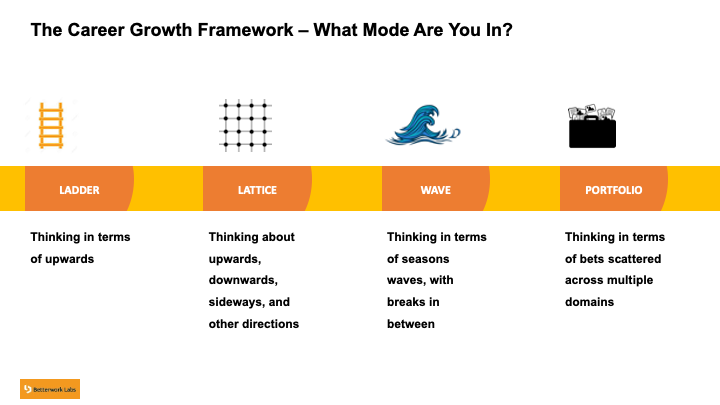Finding Your Career Growth Mode
A framework for thinking about your career development and growth
One of the beautiful things about our careers is that there isn’t a right way to do them, there is only the way that makes the most sense for you. This is both exciting and perplexing, especially when it comes to trying to be strategic about managing your career. On one hand, knowing you have agency over your career can be empowering. But when the sky's the limit, we can be paralyzed with the endless possibilities.
To complicate matters, in our never ending quest for career advice, we often fall upon universal platitudes that are well-intended, but often incredibly unhelpful. For example, take this recent research paper which did a meta analysis on studying four commonly accepted pieces of career advice, and evaluated them for their efficacy. Turns out, when held to research standards and science, some of these are not as useful as they were intended to be, and in some cases detrimental.
So, how can you be strategic and thoughtful about making career choices, in a way that balances your own unique path, but also is grounded in at least some level of structure and strategy for career development?
Introducing The Career Growth Framework: 4 Modes of Managing Your Career
After evaluating lots of career advice around career development and growth, and talking with lots of people about how they approach developing a strategy for their own career decisions, I developed the Career Growth Framework as a way to help people identify their own unique and personalized career growth mode that can help them align their current career aspirations and vision with the actions they can take to achieve those desired ambitions within their current life and work.
I came up with this framework to help people strategically align their aspirations for career growth with the actions they could take to achieve that growth. With the Career Growth Framework, individuals can take their own current aspirations and ambitions with their career, identify the mode they most closely align with, and use that as a guiding light to plot specific decisions and actions around jobs, roles, and career outcomes. Here is how it works:
The Ladder
This one is usually understandable, and something that many of us understand. This is all above looking at career growth as linear, and growing as a means of getting higher up, getting ahead and in many cases, as fast as possible. At one point in time, this was seen as the predominant way of viewing career development and growth. The way forward, if this is how you are thinking about growth, is understanding what it takes to move up the ladder, ensure that you are demonstrating those skills and abilities, and having people who support you moving up. While traditionally, this meant doing so at one company, today’s environment is such where it's also common to do so by moving around to another company.
Key Questions to Ask Yourself
If you’re considering the ladder, consider asking yourself the following questions:
What specifically is motivating me to move upward?
What skills do I need to demonstrate to move to the next rung?
Who is going to support me in my desire to move up?
The Lattice
The lattice model, as mentioned, was coined around the early 2010s by Cathy Benko in her book The Corporate Lattice. In contrast to the ladder, it is more adaptive and expansive. It represents the multidirectional ways in which employees can find and progress in their own development within the organization and in their career. Instead of just simply climbing upwards, they can climb across, horizontally, downward, etc. In this model, the desire to move around the lattice is not just for compensation (although it could be a motivator) but rather growth and development – instead of just trying to earn more money or increase your responsibilities, it means growing in other ways, such as skill sets, new opportunities, new experiences in different departments, functions, or roles. Etc
Key Questions to Ask Yourself
If you’re considering the lattice, consider asking yourself the following questions:
What skills do I have, or do I want to build?
How much of a transition do I hope to make?
The Wave
The third mode is the wave, which was coined by Josh Bersin the longtime HR Analyst. This model encourages us to think about our careers just like a surfer would – in iterations and waves. Just like a surfer, we can catch a wave, ride it for the duration, and then once it falls, paddle back in, and look for another wave.
The purpose of the wave is meant to illustrate the fast-changing nature of the work environment and industries and market’s in today’s technology driven age. Or, we have events like global a global pandemic, which both start new waves to catch (where jobs are plentiful) and crest certain waves (where jobs wash ashore) Each wave gives us the chance to gain something new – new skills, experiences, as well as a chance to re-train and train. Furthermore, in between waves, we have a chance to figure out how we want to prepare or train for the next wave – unique to this is that it makes training (or perhaps education) continuous and lifelong, which is different from our traditional high school to higher education model which we have today.
Key Questions to Ask Yourself
If you’re considering the wave, consider asking yourself the following questions:
How do I find ways to learn and grow in between waves?
How do I know when a wave is going to fall, or when it's time to find a new wave?
The Portfolio
The portfolio career growth model means looking and investing in career growth across a portfolio of investments or “bets.” This means using your skills in many ways through multiple “jobs” or income sources, rather than just one job at a single company. Just like a venture capitalist or stock broker invests in a portfolio of companies, you are investing your skills (to generate returns through income) in multiple different avenues. While this is most commonly seen in industries where freelancing reigns (ex: journalism, design, entertainment) it can also be a lens of thinking about having a full-time job but also building a side hustle.
Key Questions to Ask Yourself
If you’re considering the portfolio, consider asking yourself the following questions:
What skills or strengths do I want to use most?
How do I balance generating income and interest?
How do I think about integrating work and life?
Additional Considerations
1) None of these are going away
All of these models exist right now for professionals at large, and I don’t see them going away anytime. This is also why I strongly believe that frameworks and mental models can be more useful than blanket proclamations. If we assume that the average employee is somewhere in one of these four paths, I think there will be shifts/pushes towards specific choices in the framework given the transformation that has gone on in companies and in the minds of employees over the past two years, but none of them will go extinct.
2)Some industries + functions have models that are more likely than others
Some models are more amenable and relevant in certain industries. For example, industries that tend to be hierarchical and slow to make changes will probably have more of a ladder model. In these industries, generally speaking, the predominant model is the ladder – in order to advance, you put in your dues at each of the levels before you make managing director or partner.
While some of this is changing (ex: law firms that have specialist tracks or boutique law firms that are the “anti-big firm” model, boutique investment banks,) generally speaking, there is a model that tends to win out. For creative employees, such as graphic designers, writers, and journalists, you can see some employees who are on more of a ladder or lattice (generally speaking, full-time employees) whereas others who pursue more of a portfolio approach (a freelance editor, or a graphic designer who chooses to also teach online and do freelance graphic design work.)
3)Over time, your career growth option may change
The career growth framework strategy you choose at one part of your career may different when you are at another stage of life or career, or in another field or industry. It is normal, and accepted.
One of the things I think about with respect to the conversation around the future of work is that the way in which we as employees choose to work is going to continue to evolve. In a world of work where there isn’t a set strategy and things continue to evolve fast, I think that having intention and autonomy over how you optimize for career growth is very important. I also think it's different for everyone, and hope that the Career Growth Framework provides you with a mental model to develop your own unique career strategy and take the right steps toward achieving it.
Questions For You: I’d love your feedback on this framework:
What mode most resonates with you right now?
Am I missing anything? Is there a mode that I didn’t consider?
How do you know which mode you are in?




